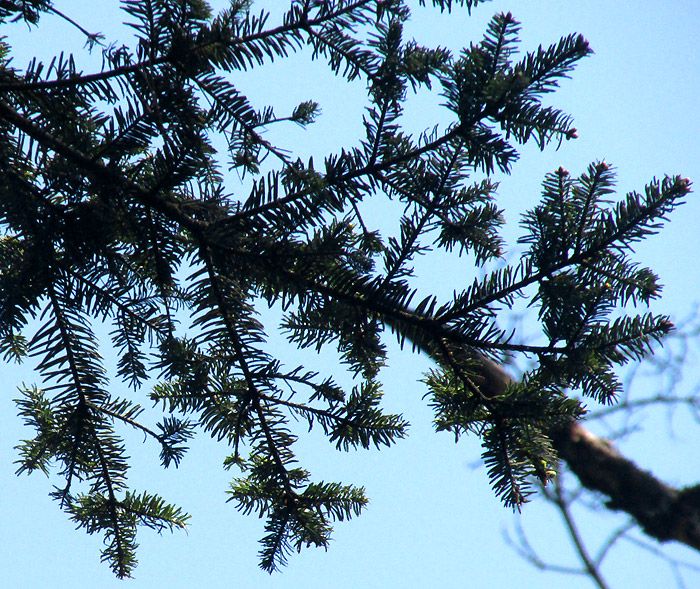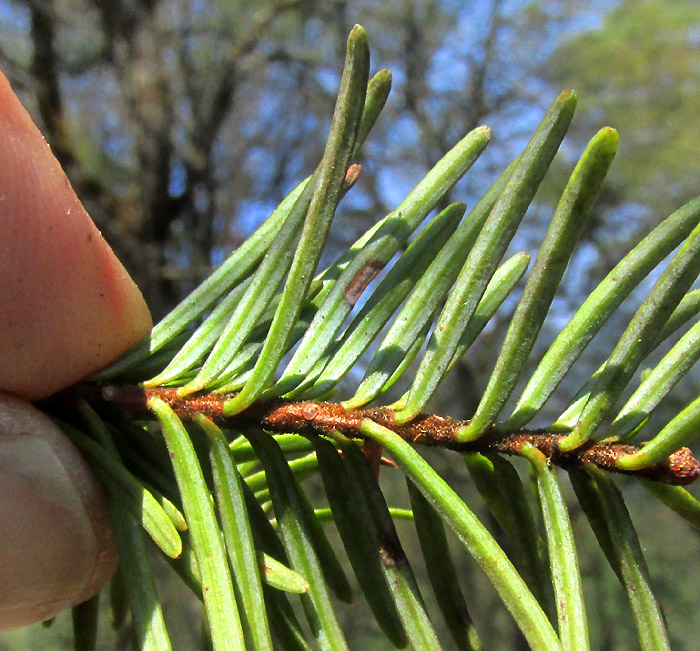Excerpts from Jim Conrad's
Naturalist Newsletter
Entry dated April 19, 2024, from notes taken about 1.5km northeast of Puerto de los Velazquez, Municipality of Pinal de Amoles; N21.138°, W99.667°, elevation ~2820 meters (~9220 feet); oak/pine/fir forest on limestone bedrock; in the Eastern Sierra Madre Mountains of east-central Querétaro state, MÉXICO
SACRED FIR

In this area, as you climb in elevation you start out in semiarid scrub, then mesquites and cacti give way to juniper, oaks and pine. As you keep climbing the junipers drop out and atop the mountains you begin seeing evergreen trees with branches like those shown above.
Here, at higher elevations, when evergreen tree leaves are short, slender and flattish like those above, and at the tips of branches new shoots along the stem project outward so that vaguely they form what's recognized as the Christian Cross, you have a Sacred Fir, ABIES RELIGIOSA.

The above young stem from our tree shows that the slender, flattened leaves arise singly in a spiraling manner around the stem, but the blades twist around so that they more or less align on two sides of the stem, like a feather's barbs on its rachis; they're somewhat two-ranked. Note that on the leaves' undersides silvery lines run along the green midrib. Yew trees, occurring a bit farther to the east, bear similar leaves, but when they fall off, short "stumps" remain on the stem. When fir leaves are removed -- above, one leaf has been pulled off -- a round scar is left flush with the stem, leaving no stump. Note that our fir's leaves' have rounded, not pointed, tips. My fingers provide scale for leaf length; the tallest one in the photo is about 3.1cm (1.2 inch) long.

Above, that's the trunk, and it was one of the biggest on that slope. Beneath the tree a diligent search found no cones at all, except for many pine cones which had rolled downslope.
In this upland central Mexican state of Querétero, three species of Abies have been documented. There's A. durangensis, A. guatemalensis, and A. religiosa. Without cones, it can be hard to distinguish fir species.
Of Querétaro's three firs, A. durangensis is a north-Mexican species, barely entering our area, and I find no records of it occurring in the vicinity of our tree in east-central Querétaro. A. guatemalensis is mainly southern Mexican and Central American. Conceivably it could be in this part of Querétaro, but leaves of the A. guatemalensis subspecies found in our area average noticeably longer than 3.1cm and often its leaf tips are notched. The IUCN Red List considers it endangered for extinction, while A. religiosa is a species of least concern.
In fact, in Mexico, it's been common practice on high-elevation slopes to clear away vegetation to make room for plantations of A. religiosa. At our tree's east-central Querétaro location, ABIES RELIGIOSA is the commonly, perhaps only, fir occurring, and that's what we have.
An untitled Mexican government website page about the Sacred Fir says that in Mexico the most important use for the tree is as a "Christmas tree." Also its branches are used as adornments during religious ceremonies. Moreover, the tree's wood, though not considered of very good quality, is recommended for making paper. Still, the wood is used as posts for electrical lines, fenceposts, and the construction of boxes, doors, broomsticks, and such.
The tree's resin can be harvested and distilled to produce turpentine, which in many societies is used medicinally for numerous ailments. Rosa María Fonseca, in a 2016 article entitled "Los" Abies u Oyamales, published by UNAM, Mexico's main university in Mexico City, writes that in Mexico fir turpentine has been used as a diuretic and a laxative, to treat ulcers and kidney stones, and to heal wounds. Fir buds can be soaked in water and used against colds and coughs.